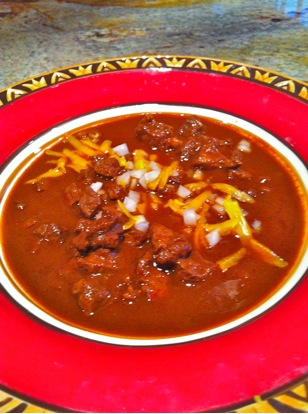“Chili” – Carne Con Chile

Chili, the Tex-Mex version, is different from the original “Carne Con Chile.” What’s Carne Con Chile you say? It means “Meat With Chile” and it’s one of the oldest and most common Texas Mexican dishes whose technique is shared with all the other regions of Mexican cuisines. It’s sometimes made with green chiles as in the state of Jalisco where a dish, made with Chile Serrano, is called “Carne En Su Jugo.” More often it’s made with red chiles as in the state of Oaxaca where a dish made with Chile Guajillo is called “Chileajo.” There are hundreds of creative and delicious recipes for cooking meat with chile, “Carne Con Chile.”

Here in our region we combine several red chiles to foreground the flavor of the meat, whether that be the traditional native venison, or the more recent (1500s) imported meats like beef or pork.
“Chili” is the anglicized word for “chile.” Anglo Texans who migrated from Europe fell in love with the various native dishes, all made with creative combinations of chiles. In San Antonio, for example, Native Mexican business women operated open air food stands in the 1800s. They served a wide array of indigenous food: enchiladas, tamales, tortillas and carne con chile. All these dishes used chiles as the predominant flavoring but it seems that “chili” was easier for the newly-arrived to pronounce so it stuck as the popular term. But traditional Mexican restaurants like the venerable Mi Tierra in San Antonio continue to use the term, Carne Con Chile. Michael Cortez, son of Pete and Cruz Cortez who first opened “Mi Tierra” (My Land) in 1941, uses the original recipe and he naturally calls it “Carne Con Chile.”
It’s a cool day here in Houston and making Carne Con Chile, aka “Chili,” just feels like it’s the right thing for body and soul. This recipe is one I hope you will like. I use Ancho chiles as the base, Guajillo for red color, and Chipotle for a nice tang. The other seasonings are a classic Texas Mexican combination that I think blends perfectly such that you don’t have one flavor springing up over any other.
Recipe for Carne Con Chile, aka Chili (serves 6)
Excerpted from the book: Truly Texas Mexican: A Native Culinary Heritage In Recipes
Ingredients:
4 Chile Ancho, seeded, deveined
2 Chile Guajillo, seeded, deveined
1 Chipotle, seeded, deveined
2 garlic cloves, unpeeled
1 medium white onion, peeled
1/2 tsp powdered cumin
1 tsp fresh Mexican Oregano
2 tsp salt
2 Tbs Canola oil
2 lbs chuck shoulder roast, cut into 1/2″ cubes
3 cups water
Method:
1. Place all the chiles in a large saucepan, cover them with water and bring to a boil. Turn off the heat and let the chiles cook for 15 minutes.
2. Heat a comal or a cast iron skillet on high, then roast the onion and the garlic until the onion has softened and has black spots. Peel the garlic after it has cooked and become soft.
3. Cut the the roast into 1/2″ cubes or smaller, trimming off the fat as you go. This is a time- consuming task, so if your butcher is friendly she might agree to do this for you when you buy it.
4. Add 1 Tablespoon Canola to a skillet on very high heat and quickly brown the meat for only 5 seconds or so. Set aside.
4. In a blender, place the chiles and all the spices. Add about a cup of water and blend on high to make a very smooth purée, adding additional water as necessary. If there are flecks in the purée, strain through a fine mesh sieve.
5. Heat a dutch oven (cast iron if you have one, but not necessary) on medium heat, add the oil and then “fry” the chile purée. Be prepared for some splatter. Cook for 10 minutes, stirring all the while.
6. Add the beef and 3 cups of water and bring to a very slow simmer. By this I mean that you’ll see only small, slow bubbles on the surface. Cover and cook for 2 hours, all the while adjusting the heat so that it stays on a slow simmer and does not boil. Uncover and cook for another 30 minutes or so to thicken. Adjust the salt.
Serve the carne con chile immediately or the next day with garnish of diced white onion, cheddar cheese, diced and pickled Jalapeños. Make sure you make plenty because it will taste fantastic the following day.
!Buen Provecho!
This recipe sounds good and I intend to make it when the weather turns cooler. Since this is a Mex-Tex cookbook, I will use this recipe to prove, once and for all, that pinto or kidney beans have no place in proper chili. After serving almost 30 years in and around the US Navy, I have grown weary arguing with my north of the Tejano border friends about beans and chili.